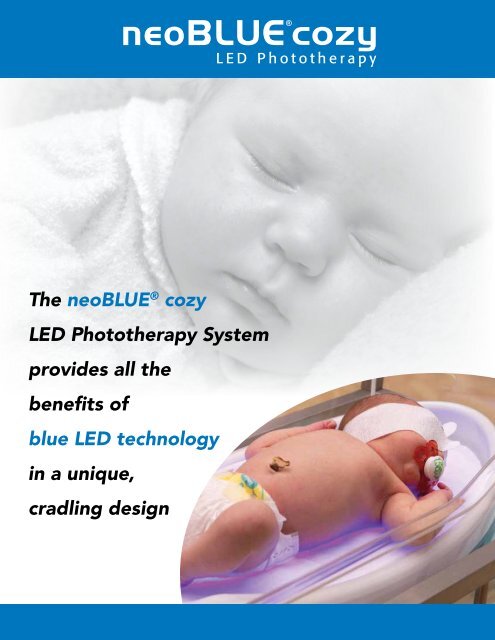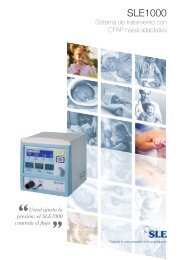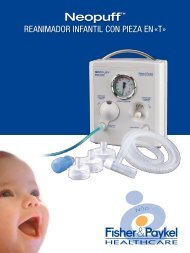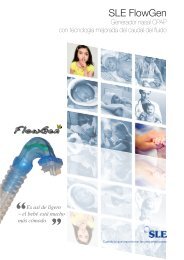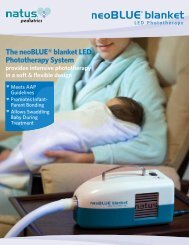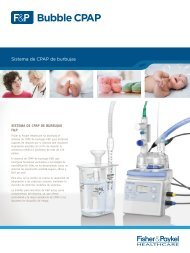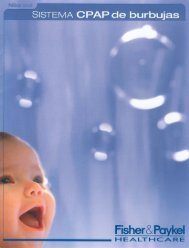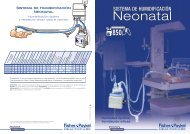The neoBLUE® cozy LED Phototherapy system ... - Cepco SAC
The neoBLUE® cozy LED Phototherapy system ... - Cepco SAC
The neoBLUE® cozy LED Phototherapy system ... - Cepco SAC
Create successful ePaper yourself
Turn your PDF publications into a flip-book with our unique Google optimized e-Paper software.
<strong>The</strong> neoBLUE ® <strong>cozy</strong><br />
<strong>LED</strong> <strong>Phototherapy</strong> System<br />
provides all the<br />
benefits of<br />
blue <strong>LED</strong> technology<br />
in a unique,<br />
cradling design
<strong>The</strong> neoBLUE <strong>cozy</strong> <strong>system</strong> is positioned underneath the baby<br />
to deliver phototherapy via a blue <strong>LED</strong> light source<br />
Most Effective Degradation of Bilirubin 1<br />
<strong>The</strong> neoBLUE <strong>cozy</strong> <strong>system</strong> meets AAP Guidelines<br />
for intensive phototherapy 2 <br />
• Intensity: Delivers intensive phototherapy: > 30 µW/cm 2 /nm<br />
• Spectrum: Utilizes blue light emitting diodes (<strong>LED</strong>s)<br />
<strong>LED</strong>s emit blue light in the 450 – 470 nm spectrum —<br />
matching the peak absorption wavelength (458 nm)<br />
Absorbance<br />
4000.00<br />
3500.00<br />
3000.00<br />
2500.00<br />
2000.00<br />
1500.00<br />
1000.00<br />
500.00<br />
Emission Spectra of Blue <strong>LED</strong>s in Relation to Bilirubin Absorption<br />
Peak absorption wavelength<br />
of bilirubin (458 nm)<br />
at which bilirubin is broken down 1<br />
0.00<br />
380 417 454 490 525<br />
Wavelength (nm)<br />
• Surface area coverage: Exposes full length of baby from head to toe<br />
Delivers phototherapy over a larger surface area than standard phototherapy blankets, pads or beds<br />
Safe<br />
• neoBLUE <strong>LED</strong>s do not emit light in the ultraviolet (UV) range— reducing the potential risk of skin damage<br />
• neoBLUE <strong>LED</strong>s do not emit light in the infrared radiation (IR) range — reducing the potential risk of fluid loss<br />
• Device automatically shuts off in the event of elevated surface temperature<br />
Flashing indicator light alerts staff to check for blocked air vents or<br />
an increase in ambient temperature<br />
Indicator Light<br />
Optimal Efficiency & ease of use<br />
designed for comfort & support<br />
• Streamlined, oval design conforms to the shape of the baby<br />
• Special neoPAD mattress provides comfortable cushioning<br />
underneath the infant<br />
Disposable mattress covers ensure clean, soft surface for baby<br />
• Blanket rolls or bumpers can be used as desired for added<br />
positioning & cushioning around the baby<br />
• Blanket can be placed over the baby for added warmth & comfort<br />
• <strong>LED</strong>s reduce costly and time-consuming bulb replacements<br />
by providing thousands of hours of use<br />
• Device timer assists in tracking overall usage of <strong>LED</strong> panel<br />
• <strong>LED</strong> panel is field serviceable — no downtime associated with patient care<br />
• Illustration on <strong>LED</strong> panel guides users on the proper placement of the baby<br />
• Accommodates babies up to 22” (55.9 cm) in length<br />
1 Vreman HJ, et al. Light-emitting diodes: a novel light source for phototherapy. Pediatric Research. 1998; 44(5):804-809.
<strong>The</strong> neoBLUE <strong>cozy</strong> <strong>system</strong> facilitates use in multiple<br />
configurations and patient care settings<br />
IDEAL FOR USE IN THE NURSERY, MOTHER’S ROOM, OR EVEN AT HOME<br />
• Portable and lightweight design allows transport to different locations<br />
• Fits easily within existing patient enclosures, such as cribs, bassinets and radiant warmers<br />
neoBLUE <strong>cozy</strong> <strong>system</strong><br />
in a bassinet<br />
A blanket may be placed over<br />
the baby for added warmth<br />
during phototherapy<br />
neoBLUE <strong>cozy</strong> <strong>system</strong><br />
on a radiant warmer<br />
<strong>The</strong> neoBLUE <strong>cozy</strong> <strong>system</strong> can<br />
be used in conjunction with an<br />
overhead neoBLUE light for<br />
expanded coverage<br />
2 Subcommittee on Hyperbilirubinemia. American Academy of Pediatrics clinical practice guideline: Management of hyperbilirubinemia in the<br />
newborn infant 35 or more weeks of gestation. Pediatrics. 2004; 114(1):297-316.
Ordering Information<br />
ItEM<br />
part Number<br />
neoBLUE ® <strong>cozy</strong> <strong>LED</strong> <strong>Phototherapy</strong> Light, 110V 010121<br />
neoPAD mattress (box of 2) 040874<br />
Disposable mattress cover (box of 50) 030760<br />
Biliband ® Eye Protectors (available separately)<br />
Regular Size 900642<br />
Premature Size 900643<br />
Micro Size 900644<br />
Technical Specifications<br />
Light Source<br />
Blue <strong>LED</strong>s<br />
Wavelength<br />
Blue: Peak between 450 and 470 nm<br />
Intensity<br />
Peak intensity at patient surface<br />
> 30 µW/cm 2 /nm<br />
Variation in intensity over 6 hrs<br />
± 10% (within illumination area)<br />
Effective treatment area Approximately 8.5 in (21.6 cm) x 17.5 in (44.5 cm), > 95 in 2 (613 cm 2 )<br />
Patient area<br />
10.7 in (27.18 cm) x 22 in (55.85 cm)<br />
Intensity ratio<br />
> 0.4 (minimum to maximum)<br />
Heat output<br />
104° F (40° C) maximum surface temperature<br />
Electrical specifications<br />
Input<br />
Voltage 100–240 V~<br />
Current 2.0 A maximum @ 100–240 V~<br />
Frequency<br />
50–60 Hz<br />
Power Supply Output (Use only with Natus Power Supply 600157)<br />
Voltage<br />
12 V<br />
Power<br />
65 W maximum<br />
Current<br />
5.4 A maximum @ 12 V<br />
Safety<br />
Main enclosure leakage current<br />
< 100 μA<br />
Earth leakage current<br />
< 250 μA<br />
Audible Noise<br />
< 60 dB<br />
Dimensions<br />
Width x Length x Height (Enclosure) 12 in (30.5 cm) x 25.5 in (64.8 cm) x 4.0 in (10.2 cm)<br />
Weight (Enclosure + Power Supply) < 11.0 lbs (5.0 kg)<br />
Environmental<br />
Operating Temperature/Humidity<br />
68° to 86° F (20° to 30° C) / 10% to 90% non condensing<br />
Storage Temperature/Humidity<br />
-22° to 122° F (-30° to 50° C) / 10% to 90% non condensing<br />
Regulatory Standards<br />
FDA classification Class II/21CFR 880.5700<br />
Electrical Safety<br />
UL60601–1:2003, CSA C22.2 601–1–M90<br />
Type BF<br />
MDD Classification<br />
IIa, (Annex IX, Rule 9, active therapeutic device)<br />
Electrical Safety EN 60601–1:1990; A1:1993; A2:1995; A13:1996<br />
EMC [Class B] EN 60601–1–2:2002<br />
Labeling<br />
EN1041:1998, EN980:2003<br />
Risk Analysis ISO 14971:2000; A1:2003<br />
Device specific safety<br />
EN60601–2–50:2002<br />
Biocompatibility<br />
EN ISO10993–1:2003; EN ISO10993–5:1999; EN ISO10993–10:2002<br />
Note: Specifications are subject to<br />
change without notice.<br />
Natus Medical Incorporated<br />
5900 First Avenue South • Seattle, WA 98108 USA<br />
1-800-303-0306 • www.natus.com<br />
P/N 051737E


